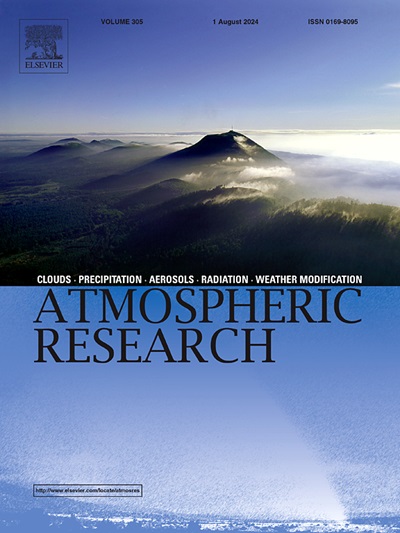Coupling effects of moisture sources and meteorological factors on stable isotopes in precipitation over the Hunshandake Sandy Land, northern China
IF 4.5
2区 地球科学
Q1 METEOROLOGY & ATMOSPHERIC SCIENCES
引用次数: 0
Abstract
Effective management of water resources and the development of climate adaptation strategies in arid and semi-arid regions increasingly rely on a comprehensive understanding of water cycle processes in the context of global climate change. This study focuses on the Hunshandake Sandy Land, a key ecological barrier in northern China. It analyzes the influence of climate conditions and moisture sources on precipitation isotope composition using 394 precipitation samples collected between 2014 and 2021. Precipitation δ18O and d-excess show significant variability and distinct seasonal patterns, with δ18O values ranging from 1.78 ‰ to −24.51 ‰ and d-excess values from −26.28 ‰ to 39.08 ‰. Temperature is identified as the primary factor influencing precipitation δ18O and d-excess, accounting for 42 % of the monthly δ18O variation and 16 % of the monthly d-excess variation. The Local Meteoric Water Line, δ2H = 6.66δ18O – 3.48, highlights the dry, low-rainfall, and high-evaporation characteristics of the Hunshandake Sandy Land. The backward trajectory calculations reveal that northern China, central China, and Mongolia are the primary sources of moisture absorption, contributing 38.25 %, 26.20 %, and 14.21 % of the moisture to Hunshandake Sandy Land precipitation, respectively. The influence of monsoon climates varies over time, leading to significant variability in the contribution of different moisture source regions to Hunshandake Sandy Land precipitation. Specifically, northern China contributes 36.09 % of the moisture in the wet season and 40.42 % in the dry season, whereas central China contributes 29.39 % in the wet season and 23.02 % in the dry season. The Hunshandake Sandy Land precipitation sample index (IHSL) was defined, and a multiple linear model for monthly precipitation δ18O values was developed using temperature, relative humidity, and IHSL: (δ18O = 0.320 T - 0.068RH + 0.022 IHSL - 11.615). This model can explain 49 % of the monthly precipitation δ18O variability.These findings enhance the understanding of the water cycle in arid and semi-arid regions.
湿源与气象因子对浑善达克沙地降水稳定同位素的耦合效应
在干旱和半干旱地区,水资源的有效管理和气候适应战略的制定越来越依赖于对全球气候变化背景下水循环过程的全面了解。本文以中国北方重要生态屏障浑山达克沙地为研究对象。利用2014 - 2021年收集的394份降水样本,分析了气候条件和水分来源对降水同位素组成的影响。降水δ18O和d-excess表现出明显的季节变化特征,δ18O值在1.78‰~ - 24.51‰之间,d-excess值在- 26.28‰~ 39.08‰之间。气温是影响降水δ18O和d-excess的主要因子,分别占δ18O月变化的42%和d-excess月变化的16%。局地大气水线δ2H = 6.66δ18O - 3.48,突出了浑山达克沙地干燥、少雨、高蒸发的特征。反轨迹计算表明,华北、华中和蒙古是浑山达克沙地降水的主要吸湿源,分别贡献了38.25%、26.20%和14.21%的水分。季风气候的影响随时间的变化而变化,导致不同水汽源区对浑善达克沙地降水的贡献存在显著差异。其中,华北地区湿季占36.09%,旱季占40.42%,中部地区湿季占29.39%,旱季占23.02%。定义了浑山克沙地降水样本指数(IHSL),利用温度、相对湿度和IHSL建立了月降水δ18O的多元线性模型:(δ18O = 0.320 T - 0.068RH + 0.022 IHSL - 11.615)。该模式可以解释49%的月降水δ18O变率。这些发现加强了对干旱和半干旱地区水循环的认识。
本文章由计算机程序翻译,如有差异,请以英文原文为准。
求助全文
约1分钟内获得全文
求助全文
来源期刊

Atmospheric Research
地学-气象与大气科学
CiteScore
9.40
自引率
10.90%
发文量
460
审稿时长
47 days
期刊介绍:
The journal publishes scientific papers (research papers, review articles, letters and notes) dealing with the part of the atmosphere where meteorological events occur. Attention is given to all processes extending from the earth surface to the tropopause, but special emphasis continues to be devoted to the physics of clouds, mesoscale meteorology and air pollution, i.e. atmospheric aerosols; microphysical processes; cloud dynamics and thermodynamics; numerical simulation, climatology, climate change and weather modification.
 求助内容:
求助内容: 应助结果提醒方式:
应助结果提醒方式:


